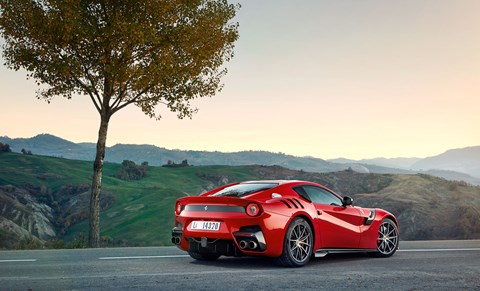► We drive the madcap Ferrari F12tdf
► With power boosted to 769bhp, it’s electric-fast
► Full feature review of the fastest F12 in history
Imagine a North Korean military parade where all the tanks are V12s, the jets GTOs and the scuds are Scuderias. That’s the Ferrari World Finals at Mugello circuit, midway between Florence and Bologna. It’s a celebration of all things Maranello, a giant self congratulatory pat on the back, free to watch, dripping with stunning metal and utterly fascinating – from an anthropological aspect, as much as an automotive one. Wide-eyed kids with flags, men with draped sweaters and those weird suede girl’s shoes and hardcore motorsport geeks rub shouders in a melting pot of Maranello mania.
When we arrive on the last day of the four-day event to see the unveiling of the F12tdf, fans are openly pinching the cloth hoardings and wheeling away used race slicks as momentos. The point is these people are rabid Ferrari fans. Maranello could do something really awful, like rebadge a Toyota IQ, and this lot would lap it up, so a limited-run F12 named after a legendary road race from the marque’s past would be a gift from God, even if it was nothing more than an ECU map and a set of rims. But Ferrari doesn’t play that game. The fastest Ferrari this side of a LaFerrari is the result of a seriously involved development programme, a car that’s as challenging to drive well as it must have been to engineer.
And that’s nothing like the challenge of retaining any sense of decorum and professionalism when test driver Raffaele de Simone reacquaints the throttle pedal with the bulkhead. Your mouth involuntarily drops wide open and a pre-pubescent yelp exits into a mosh pit of intake and exhaust roar. Six months ago, sitting alongside the same man on the same track in a 488GTB, the yelp didn’t come. And neither did the yowl. This visit they both have a perfect attendance record.
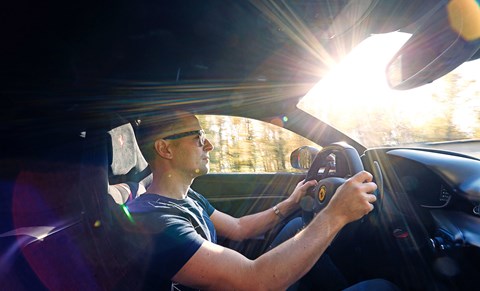
Since Ferrari went forced-induction there’s been a wave of nostalgia for the old naturally-aspirated V8 as fitted to the 458. But Ferrari’s V12 is still here and at the very top of its game. Already capable of producing 720bhp and 509lb ft in the F12 Berlinetta, for the tdf it gains tricks such as variable height intake trumpets and mechanical, rather than hydraulic, tappets. Power climbs to 769bhp and torque to 520lb ft and the rev limiter has been raised by 400rpm. What’s more, the seven gear ratios are shorter, to make the car feel even faster still. The 0-62mph sprint takes 3.1sec in the standard car but only 2.9sec here, an incredible achievement for a front-engined, two-wheel-drive car.
But the extra power is only half the story. This very special F12 weighs 110kg less than an F12 Berlinetta thanks to extensive use of carbonfibre. Now take another look at that side profile. The window line is completely different aft of the door, as is the rake of the rear screen. You won’t miss the famous GTO-style triple vents on each side either, the offside one mercifully drawing your attention from the awful oversized filler cap. There are no model-specific badges on the outside of the car, just one ‘tdf’ inside, on the dashboard, but nothing to explain it. Tour de France is the full title, and the name of a famous race Ferrari dominated in the ’50s and ’60s with its front-engined V12 GTs. But the spoilsport bike people behind the modern two-wheel event wouldn’t let Ferrari use the full name, so Maranello’s gone with a lower-case abbreviation to tdf. Terrible, but kind of fitting: everything is lighter and more focused on this car.
But the biggest change is one you can’t see or hear. Feel it though, you most definitely do. It’s a bit of new technology Ferrari calls Passo Corto Virtuale or Virtual Short Wheelbase, which neatly shoehorns in a reference to a famous old Ferrari, which is perhaps why it’s called that and not Virtual Long Wheelbase, which would be more accurate but less romantic. Essentially it’s a four-wheel-steer system that’s designed to promote rock-solid high-speed stability, and faster lap times as a result. It’s needed because Ferrari has bumped front tyre width up from 255 to 275mm. That has massively improved front-end grip and response, but it would have made the F12 flighty and darty on its stock 315mm rear tyres. PCV redresses the balance.
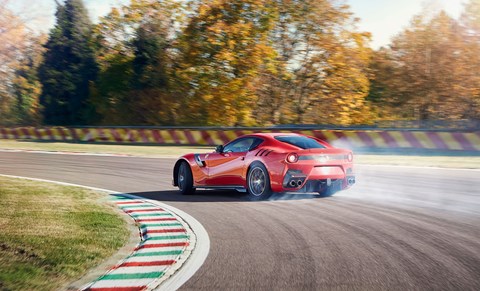
At very, very low speeds and when manoeuvring, the rear wheels turn the opposite way to the fronts to improve agility, giving the feel of a shorter car. But turn up the heat and the speed and those rear wheels will point the same way as the fronts to stabilise the car. It’s not a new concept: the Japanese were all over it in the ’80s, and it was a key feature on Nissan GT-Rs until the latest R35 appeared in 2007. Porsche also uses it on the current 911 Turbo. But it’s the first time it’s been employed on a Ferrari and it radically transforms the way this car drives. In engineering terms the LaFerrari
hybrid was vastly more complicated, yet to drive it’s a pussycat compared to the tdf’s rabid tiger.
We’re at Ferrari’s Fiorano test track for our customary handful of laps. It’s a pretty interesting crowd today. Film director Michael Mann and American Psycho actor Christian Bale are standing a few feet away, here to talk about the Enzo biopic they’re working on. And in the background is the man who, of anyone on the planet, most closely resembles the icon Bale needs to emulate. Piero Ferrari, a newly minted dollar billionaire following the £6.5billion flotation of the company in which he owns a 10% stake, steps from a 488GTB. In an elegant suit, hair combed back from a face dominated by those eyes, he looks the spit of his father as seen in those powerful black and white pictures from the ’40s.
Test driver Simone takes me for a couple of passenger laps, starting slowly as always, explaining the philosophy behind the car as he goes. This is not a softer car than the old 599 GTO, he says, but the four-wheel steering gives it a greater depth of character, a broader spread of talents. When required, it also helps it go obscenely fast. The F12tdf laps Fiorano in 1m 21sec, 2sec faster than a 488GTB or F12 Berlinetta. Only LaFerrari, at 1m 19.7sec, is quicker.
I’ve sat here a dozen times but it’s never any less fascinating to watch Simone at the wheel, this slight, gentle young man, making equally slight, gentle inputs at the controls. A little nudge of steering, a brush of the brakes, an apparent brush with death if you’re a nervous passenger… We’re really shifting. I notice he’s taking a different line through the scariest corner though, cutting across the mid-track kerb on the left-hander two curves on from the hairpin. A hint at the different dynamic feel of the four-wheel-steer chassis? Or just a change of tactic made necessary by the tdf’s prodigious turn of speed?
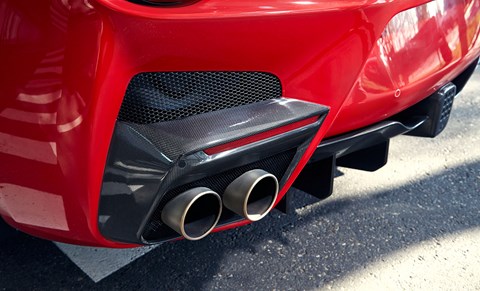
In the pits Simone vacates the driver’s seat while the technicians fiddle with tyres pressures and I get comfortable in the other chair. This is clearly a more serious device than the Berlinetta. Bare carbon abounds, punctuated by flashes of alcantara rather than heavier leather, the seats are serious-looking buckets and the glovebox has disappeared altogether in the quest to cut kilos. There’s still no keyless start (the 488 was the first Ferrari to get it) so you twist the cheap-looking key, prod the wheel-mounted starter button and grab the first of seven gears with a tug on the long, slender carbonfibre paddleshifter.
Roll out onto the empty circuit, grab a couple of seconds to take stock and then give it death to the first corner. Here comes that yelp again. And the yowl. Even by LaFerrari standards this thing feels rocket-powered in a straight line, and the way the nose tucks into the right-handerat the end of the straight without a suggestion of slip suggests it’s been borrowing handling tips from the halo car, too. The tdf’s front end is so much better than the Berlinetta’s on every level: more grip, more precision, and a welcome dose of extra steering heft. The upshot is more speed and more confidence, so you feel more able to exploit the performance.
I complete the first couple of laps with the little steering wheel manettino in Race mode, for most drivers the route to the quickest lap times. Subtly bleeding away excess power and using the electronic diff to keep the thing straight, the tdf couldn’t flatter you more if Lolita popped up on the multimedia system, telling you what a great job you weredoing and leaning out to squeeze your bicep with a ‘hmmm!’ But because you can feel its intervention, however subtle, you can’t help feeling like you want to discover more about the tdf, and whether you’re really up to the job of dealing with it.
Click the manettino up a notch to CT (traction) off, or push and hold through the three little beeps to get rid of the electronic stability programme and go completely bareback, and things start to get less straightforward. Now the front end still bites instantly, but the rear end moves freely. That means oversteer, and although the diff is shuttling torque left and right to promote stability, you still feel like you ought to be winding on some opposite lock to keep everything balanced, just as you would in an ordinary F12. I try it through the two fast left-handers but it feels clumsy. My little inputs feel like great sawing motions at the wheel and I get into a curious zig-zag motion, almost like a mini tankslapper as I wind lock on and off, trying to work out the technique. This technology is meant to make the tdf easier to drive fast, not harder, right?
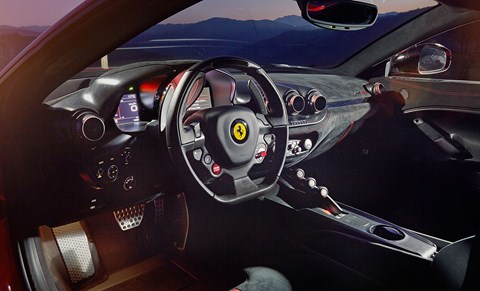
Later I grab the chance of another couple of laps and the Ferrari starts to make more sense. Make smaller inputs and correspondingly smaller corrections and everything smoothes out. Sometimes, just as you’re convinced you really ought to do something, you’re best off doing nothing at all. More than any recent Ferrari I can think of, the F12tdf is one that needs time to learn, to appreciate and to understand. Given that time it’s probably sensational, but I’m not sure I’m there yet. Maybe some road time will cement the relationship. Time is tight and light in short supply, so we make for the mountains to get as high as possible and extract every last lumen.
First impressions beyond the outright speed, which feels even more outrageous on narrow roads, the hair-trigger throttle and the orgasmic soundtrack? It’s stiff. Not harsh, but very noticeably less pliant than the standard F12, and softening the dampers with the steering wheel ‘bumpy road’ button doesn’t make as much difference as it does in the
Berlinetta either. But the good news is that you need absolutely no acclimatisation to understand the tdf’s road manners. On real roads, where you’re never likely to get near the Pirelli P Zero Corsas’ lofty limits, you can focus on that incredible front end, the excellent brake feel and power, and trying to find a straight long enough to wring the V12 out to its 8900rpm maximum. The original Tour de France that Ferrari dominated wasn’t circuit-based but a road race, and it’s on the road that this F12 really starts to get under your skin. ‘For me the tdf is more fun on the road than LaFerrari because you can push more,’ Simone told me earlier. Now, hours later, he doesn’t seem quite so mad.
Whether you or me would spend the extra £100k over an F12 Berlinetta doesn’t matter to Ferrari; every one of the 799 tdfs is spoken for. That sounds like a big production number for an exclusive car, but that means big returns: almost £80m of additional turnover. All the high-end car makers have realised that special editions are the way to make (even more) money.
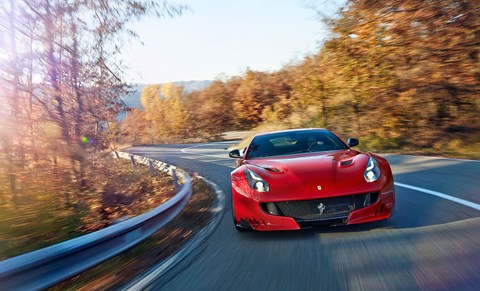
Personally, I think my ideal F12 rests somewhere between Berlinetta and tdf. I love the extra performance, the fact that it resists body movements like Hans Solo’s The Empire Strikes Back carbonite sleeping bag, and yes, on balance, I think I’ve been suckered by the styling too, or at least enough to forgive that filler cap. But I prefer the more predictable, more natural on-the-limit behaviour of the standard car, and I’d probably be willing to trade the odd tenth at Fiorano to get it. The fortunate 799 though, are unlikely to feel anything other than enraptured.
**Need to make a tdf of your F12? Here’s how it’s done
V12 spins to 8900rpm
Mechanical tappets and variable intake geometry plus a 400rpm redline increase boost the 6.3-litre V12 from 730bhp to 769bhp and torque by 11lb ft to 520lb ft. Peak torque doesn’t appear until 6750rpm, but you get 80% from 2500rpm.
Sharper Gearbox
We can’t remember complaining about the Berlinetta’s tardy shifts but in the tdf the seven-speed dual-clutch ’box swap gears 30% faster on upshifts and 40% faster going the other way. The ratios are 6% shorter to amplify the feel of the engine’s extra power.
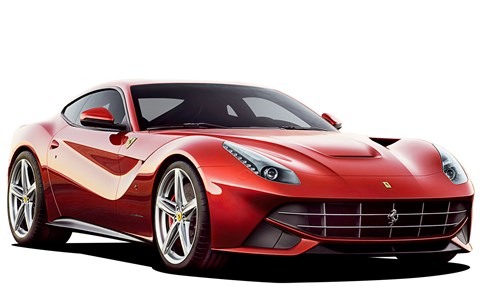
Firmer Suspension
The basic setup – double wishbones at the front and a multi-link rear – is carried over, but with firmer springs and dampers. Front tyres go up from 255 to 275mm wide for extra grip, while Ferrari’s Virtual Short Wheelbase system aims to preserve rear-end stability.
Styling and aero
Standard F12 lacks the wow factor expected in a market full of outrageous mid-engined machines. Apart from the cow-catcher front spoiler, rear diffuser with active flaps and those GTO vents, tdf gets a new side window shape and more upright back window.
Weight loss
Ferrari’s chopped 110kg from the F12 Berlinetta by upping the carbonfibre quotient, not just on external surfaces but also on the centre tunnel. Wheels feature narrow-section spokes and the interior swaps leather trim for composites and alcantara.
The specs: Ferrari F12tdf
Price: £339,000
Engine: 6262cc 48v V12, 769bhp @ 8500rpm, 520lb ft @ 6750rpm
Transmission: 7-speed dual clutch, rear-wheel drive
Performance: 2.9sec 0-62mph, 211+mph, 18.3mpg, 360g/km CO2
Suspension: Double-wishbone front, multi-link rear
Length/width/height: 4656/1961/1273mm
Weight/made from: 1520kg (est – 1415kg dry)/aluminium and carbonfibre
Rating: ****
